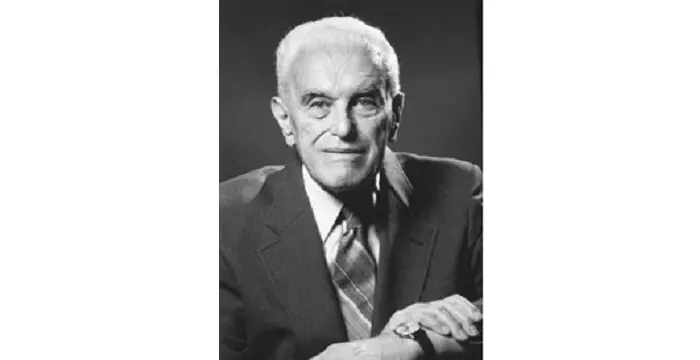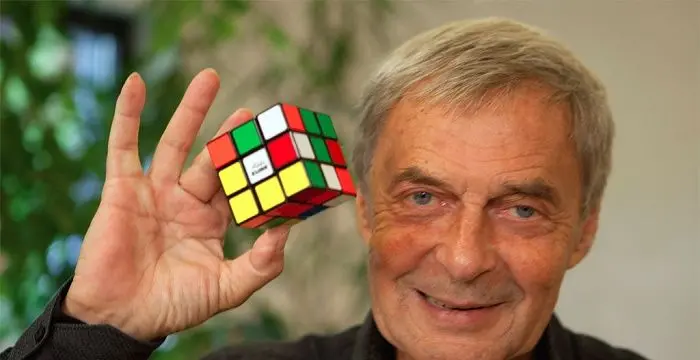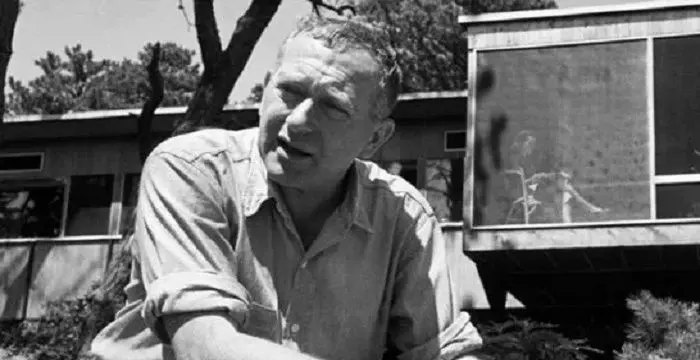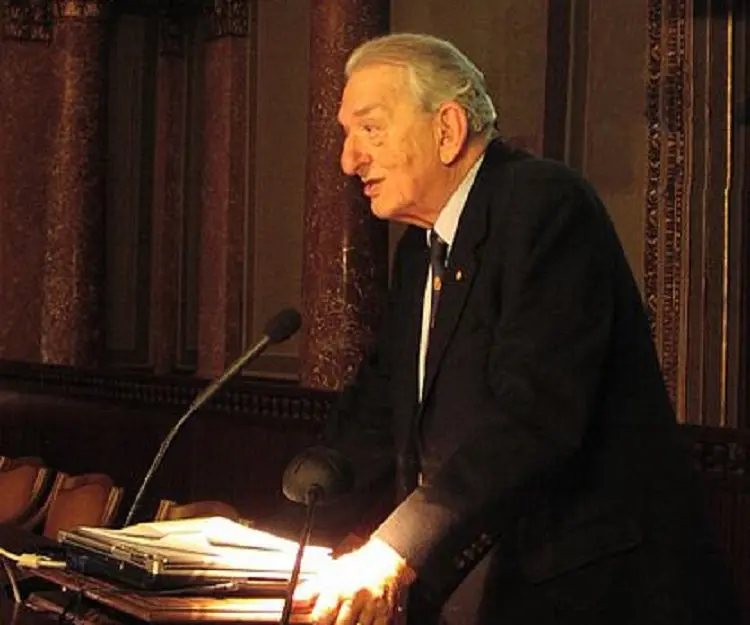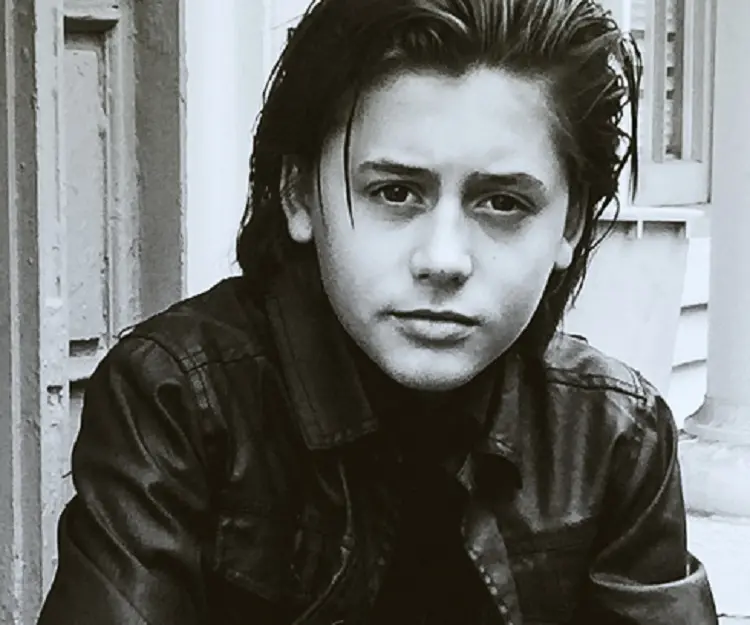
George A. Olah - Hungarian Men, Facts and Childhood
George A. Olah's Personal Details
George A
| Information | Detail |
|---|---|
| Birthday | May 22, 1927 |
| Died on | March 8, 2017 |
| Nationality | Hungarian, American |
| Famous | Scientists, Chemists, Hungarian Men |
| Spouses | Judith Lengyel (m. 1949) |
| Known as | George Andrew Olah |
| Childrens | George, Ronald |
| Universities |
|
| Birth Place | Budapest, Hungary |
| Born Country | Hungary |
| Gender | Male |
| Father | Gyula Oláh |
| Mother | Magda Krasznai |
| Sun Sign | Gemini |
| Born in | Budapest, Hungary |
| Famous as | Chemist |
| Died at Age | 89 |
// Famous Hungarian Men
John C Harsanyi
Read on to know the profile, career, important works, contributions and timeline of the famous American economist and Nobel Laureate, John C Harsanyi.
Erno Rubik
The famous inventor and educationist, Erno Rubik is known world-wide for his invention the ‘Rubik’s Cube’. To know more about the childhood, profile, timeline and career of this famous architect-inventor read on.
Marcel Breuer
Marcel Lajos Breuer was a world famous modernist architect and designer considered as one of the most prominent proponents of International Style. This biography profiles his childhood, life, career, achievements and timeline.
George A. Olah's photo
Who is George A. Olah?
George A. Olah was a Hungarian American chemist who won the 1994 Nobel Prize for Chemistry. Best known for the research which led to the isolation of the positively charged, electron-deficient fragments of hydrocarbons known as carbocations (or carbonium ions), he was also much respected for his work in the methanol economy. In addition to the Nobel Prize, he also received the Priestley Medal and F.A. Cotton Medal for Excellence in Chemical Research of the American Chemical Society. Born in Budapest, Hungary, in the late 1920s, he grew up witnessing the horrors of the World War I which ravaged his nation. The 1956 Hungarian Revolution broke out when he was a young man and his family temporarily moved to England before shifting to Canada. Upon accepting a position as a research scientist at the Dow Chemical Company in Canada, he began his pioneering work on carbocations. After several years of working in the chemical industry where he also helped to improve some industrial processes, he moved to academics with a position at Case Western Reserve University. He eventually joined the faculty of the University of Southern California at Los Angeles, where he later became director of the Loker Hydrocarbon Research Institute. Even though he had begun his breakthrough research decades earlier, it was only during the 1990s that he achieved much international acclaim for his work.
// Famous Scientists
Juliane Koepcke
Juliane Koepcke is a German-Peruvian biologist, who was the lone survivor among the 92 passengers and crew of the ill-fated LANSA Flight 508 that crashed in the Peruvian rainforest on 24 December 1971. Know more about her life in this biography.
Henry Cavendish
Henry Cavendish was a theoretical chemist and physicist, renowned for discovery of hydrogen and calculation of the mass of earth. To know more about his childhood, profile, timeline and career read on
Konstantin Tsiolkovsky
Konstantin Tsiolkovsky was a Russian rocket scientist and a pioneer of astronautics. This biography provides detailed information about his childhood, family, personal life, career, achievements, etc.
Childhood & Early Life
George Andrew Olah was born as Oláh György in Budapest, Hungary, on May 22, 1927 to Magda (Krasznai) and Julius Oláh, a lawyer. He received a typical middle-class upbringing and attended a Gymnasium (a combination of junior and senior high school) at one of the best schools in Budapest, the high school of Budapesti Piarista Gimnazium (Scolopi fathers).
As a young boy, he was more interested in history and the humanities rather than science. His school years were marred by war which ravaged the country though he successfully managed to complete high school amidst the politically chaotic and violent environment.
Having developed an interest in chemistry during his high school years, he enrolled at the Budapest University of Technology and Economics to study the subject. He was especially intrigued by organic chemistry.
He later became a research assistant to Professor Geza Zemplen, a senior professor of organic chemistry who had established a reputed school in Hungary. Olah’s experience of working with Zemplen was an enriching one.
Career
He earned his doctorate in 1949 and taught at the Budapest University of Technology and Economics until 1954. He was then invited to join the newly established Central Chemical Research Institute of the Hungarian Academy of Sciences in 1954.
Around this time he was also able to establish a small research group in organic chemistry, housed in temporary laboratories of an industrial research institute. The research group was performing well but a political situation disrupted their work.
In October 1956, Hungary revolted against the Soviet rule and the revolution turned out to be a very violent and turbulent one. There was much bloodshed and loss of life and Budapest was left ravaged by the political upheavals. In such a grim situation, thousands of Hungarians—including Olah and his family—fled their homeland to seek a better life in the West.
He first went to England for a short while before moving to Canada where he became a research scientist at the Dow Chemical Company in 1957. The company also hired two of Olah’s original Hungarian Collaborators, including Steven Kuhn.
It was during his years at Dow that he began his pioneering work on carbocations. Dow was a major user of carbocationic chemistry and Olah’s work also had practical significance and helped to improve some industrial processes.
In 1964, he was transferred to Dow's Eastern Research Laboratories in Framingham where he continued his work. He changed his job in 1965, taking up the position of a professor at the Western Reserve University in Cleveland, Ohio, where he also handled the responsibility of becoming the Department Chairman.
George A. Olah moved to the University of Southern California in 1977, where he became director of the Loker Hydrocarbon Research Institute in 1980. Over the recent years, he has shifted the focus of his research from hydrocarbons and their transformation into fuel to the methanol economy.
The Olah family has formed an endowment fund in his name—the George A. Olah Endowment—which grants annual awards to outstanding chemists. The American Chemical Society selects and administers the awards.
Major Works
Best known for his work on carbocations, George A. Olah successfully isolated the positively charged, electron-deficient fragments of hydrocarbons (carbocations or carbonium ions) through the use of superacids and ultracold solvents. His pioneering research led to the development of a new branch of organic chemistry.
Awards & Achievements
George A. Olah was awarded the Nobel Prize in Chemistry in 1994 "for his contribution to carbocation chemistry."
In 2001, he was honored with the Arthur C. Cope Award.
The Priestley Medal, the highest honor conferred by the American Chemical Society (ACS) which is awarded for distinguished service in the field of chemistry, was bestowed upon Olah in 2005.
Personal Life & Legacy
He married Judith Lengyel in 1949, and had two sons, George (born in Hungary in 1954), and Ronald (born in the U.S. in 1959).
George Andrew Olah died on March 8, 2017, at his home in Beverly Hills, California, USA.
// Famous Chemists
Henry Cavendish
Henry Cavendish was a theoretical chemist and physicist, renowned for discovery of hydrogen and calculation of the mass of earth. To know more about his childhood, profile, timeline and career read on
Walter Kohn
Nobel Laureate Walter Kohn was an Austrian-born American theoretical chemist and physicist. Check out this biography to know about his childhood, life, achievements, works & timeline.
Jabir Ibn Hayyan
Jabir Ibn Hayyan was a medieval era polymath. Check out this biography to know about his life, works and achievements.
George A. Olah's awards
| Year | Name | Award |
|---|---|---|
Other | ||
| 0 | 1994 - Nobel Prize in Chemistry | |
| 0 | 2005 - Priestley Medal | |
| 0 | 1972 - Guggenheim Fellowship for Natural Sciences; US & Canada | |
George A. Olah biography timelines
- // 22nd May 1927George Andrew Olah was born as Oláh György in Budapest, Hungary, on May 22, 1927 to Magda (Krasznai) and Julius Oláh, a lawyer. He received a typical middle-class upbringing and attended a Gymnasium (a combination of junior and senior high school) at one of the best schools in Budapest, the high school of Budapesti Piarista Gimnazium (Scolopi fathers).
- // 1949He earned his doctorate in 1949 and taught at the Budapest University of Technology and Economics until 1954. He was then invited to join the newly established Central Chemical Research Institute of the Hungarian Academy of Sciences in 1954.
- // 1949He married Judith Lengyel in 1949, and had two sons, George (born in Hungary in 1954), and Ronald (born in the U.S. in 1959).
- // Oct 1956In October 1956, Hungary revolted against the Soviet rule and the revolution turned out to be a very violent and turbulent one. There was much bloodshed and loss of life and Budapest was left ravaged by the political upheavals. In such a grim situation, thousands of Hungarians—including Olah and his family—fled their homeland to seek a better life in the West.
- // 1957He first went to England for a short while before moving to Canada where he became a research scientist at the Dow Chemical Company in 1957. The company also hired two of Olah’s original Hungarian Collaborators, including Steven Kuhn.
- // 1964 To 1965In 1964, he was transferred to Dow's Eastern Research Laboratories in Framingham where he continued his work. He changed his job in 1965, taking up the position of a professor at the Western Reserve University in Cleveland, Ohio, where he also handled the responsibility of becoming the Department Chairman.
- // 1977 To 1980George A. Olah moved to the University of Southern California in 1977, where he became director of the Loker Hydrocarbon Research Institute in 1980. Over the recent years, he has shifted the focus of his research from hydrocarbons and their transformation into fuel to the methanol economy.
- // 1994George A. Olah was awarded the Nobel Prize in Chemistry in 1994 "for his contribution to carbocation chemistry."
- // 2001In 2001, he was honored with the Arthur C. Cope Award.
- // 2005The Priestley Medal, the highest honor conferred by the American Chemical Society (ACS) which is awarded for distinguished service in the field of chemistry, was bestowed upon Olah in 2005.
// Famous Gemini Celebrities peoples
Wentworth Miller
Wentworth Miller is an American actor and screenwriter who achieved recognition for his role in the TV series ‘Prison Break’.
Joyce Meyer
Joyce Meyer is a Christian author and speaker. This biography provides detailed information about her childhood, life, achievements, works & timeline
Zoe LaVerne
Zoe LaVerne is an American musical.ly star. Check out this biography to know more about her family, personal life, including her age, birthday, etc.
WolfieRaps
Check out all that you wanted to know about WolfieRaps, the famous YouTube Personality; his birthday, his family and personal life, his girlfriends, fun trivia facts and more.
Adam Saleh
Check out all that you wanted to know about Adam Saleh, the famous YouTube Personality; his birthday, his family and personal life, his girlfriends, fun trivia facts and more.
Isaak Presley
All about American actor and singer Isaak Presley including his age, birthday, family life, girlfriends, net worth, and some fun facts.
George A. Olah's FAQ
What is George A. Olah birthday?
George A. Olah was born at 1927-05-22
When was George A. Olah died?
George A. Olah was died at 2017-03-08
Where was George A. Olah died?
George A. Olah was died in Beverly Hills, California, U.S.
Which age was George A. Olah died?
George A. Olah was died at age 89
Where is George A. Olah's birth place?
George A. Olah was born in Budapest, Hungary
What is George A. Olah nationalities?
George A. Olah's nationalities is Hungarian, American
Who is George A. Olah spouses?
George A. Olah's spouses is Judith Lengyel (m. 1949)
Who is George A. Olah childrens?
George A. Olah's childrens is George, Ronald
What was George A. Olah universities?
George A. Olah studied at Budapest University of Technology and Economics
Who is George A. Olah's father?
George A. Olah's father is Gyula Oláh
Who is George A. Olah's mother?
George A. Olah's mother is Magda Krasznai
What is George A. Olah's sun sign?
George A. Olah is Gemini
How famous is George A. Olah?
George A. Olah is famouse as Chemist
